Archives for Raves category
Posted on Sep 26, 2012 under Raves |
If you’re like me, it’s rare that I go anywhere without my phone. Well… ok, I frequently run without the phone if I’m not expecting an important call and I’m going to be in a populated area where a pay phone or taxi/transit would be easy to come by, but other than that I live a pretty tethered life. I like the convenience of having my phone at hand with it’s plethora of apps and the ability to connect with people if needed for whatever reason. When I’m out for a long ride, I’ll frequently use my iPhone as a mp3 player, etc.
Of course, constantly having a piece of somewhat fragile electronics on your person adds greatly to the possibility that said electronics will get dropped, banged, dripped on or otherwise abused. This is where the huge assortment of iPhone cases and protectors come into play.
Until today, I had never held my iPhone 4s outside of it’s Otterbox protective skin. When I bought the phone, I had the store put it in the case and didn’t actually put my hands on the phone until it’d been screen protected and enrobed in the rubberized shield. Today, that changed. Today I *gasp* removed my iPhone 4s from the Otterbox housing to test the Ballistic LS iPhone case.
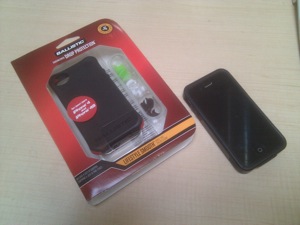
The Ballistic case is pretty cool. It’s a hard rubber case in one of 6 colours with interchangeable coloured rubber bumpers on the 4 corners that allow you to personalize your phone but still have good protection in a thin and lightweight design. The 4 corners are also slightly more cushioned than the rest of the case to give extra protection should the phone land on a corner (which would definitely cause more damage to an unprotected phone).
Inserting my iPhone into the Ballistic case 2 things were immediately apparent: the Ballistic case is generally a bit thinner than the otter case, which provides a better hand feel and, the Ballistic case doesn’t offer quite the same level of protection as the Otterbox.
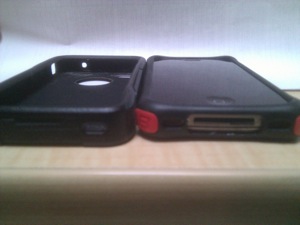
You can see from the picture above (old Otterbox case on left, new Ballistic LS case on right) that the Otterbox case is roughly as thick as the Otterbox case on the corners, but tapers to a thinner profile in the middle. This thinner profile is surprisingly noticeable, it gives the phone a better hand feel, generally feels better in the pocket and, perhaps most importantly, gives better access to the edge of the screen when you’re dragging applications from screen to screen and need to be able to swipe right to the edge of the screen (this is something that frustrated me with the Otterbox case on a regular basis).
You can also see that unlike the Otterbox case, the Ballistic case does not offer any protection to the docking port on the bottom of the phone, nor is there any covering the headphone jack on the top. Having previously used phone protectors with a similar lack of headphone and dock lint protection, I can say (at least for me) that these extra flaps of rubber are at best a false sense of security at the cost of extra weight. Given the amount of grime that was inside the Ottercase after 6 months of use, it’s fair to say that the little rubber flaps may serve to stop/slow a drop of water from entering the device, but otherwise they have no purpose. All that said, it’s be nice of the Ballistic case gave you the option by including a coloured rubber (removable) dock cover flap and/or headphone jack cover.
I, unfortunately, don’t have a budget for drop tests, but I feel, by examining the two cases, that the Ballistic LS case would provide better drop survivability to my phone than the Otterbox case. Again I don’t have any test data on this, but the Otterbox case just seems to be good general protection where the Ballistic case, while offering that general protection, also seems to be built to offer better drop protection.
Having spent a day with the Ballistic LS case I can say that I prefer it over the Otterbox case. Yes the Otter case may offer slightly better overall protection, but the Ballistic case feels better, provides better access to the phone and is lighter. Too bad Otterbox case, you’ve been replaced.
Posted on Sep 20, 2012 under Factoids, Geek Out!, Raves |
I was fortunate to have borrowed a Recovery Pump system for Ironman Mont Tremblant recovery. I wasn’t sure what to expect or if it’d make any real difference. I wore the legs for 2 hrs after the race and for 30 minutes the next morning, and while I saw people in the village hobbling around, my legs felt really good. Was this the Recovery Pump, my pacing, my physiology or some other factor.
Ian and I decided to put them to a test. Here was the plan:
On 2 subsequent Saturdays (Friday is a rest day), I’d do the following workout at 8am and again at noon. Before the 8am I’d have my normal breakfast (yogurt, bran buds and a banana), after the 1st workout I’d have a First Endurance Ultragen. During each test I would drink 1 bottle of water with First Endurance EFS Drink.
The workout was controlled as a programmed .ERG workout with the computrainer, as follows:
- Warmup: 120w-200w progressive increase over 10:00
- quick computrainer calibration
- Long Intervals: (seated) 3x 10:00 @ 30w over FTP with a 3:00 easy spin between
- 10:00 easy (during which I exited the power workout and started spinscan to be able to set a fixed grade)
- Sprint Intervals: 6x 0:10 seated sprint with 0:50 recovery
- Cooldown: 5:00
On the 1st week, we did the control. No specific recovery between the trials, just nutrition, tv, web surfing, etc. The 2nd week I used the recoverypump legs for 45 minutes after the 1st workout.
The Results
The Control
|
Trial 1 |
Trial 2 |
Delta |
| Long Intervals |
7 micro-rests |
13 micro-rests |
Performance drop by ~40% |
| Sprint Intervals |
Max 626w |
Max 603 (but most ~590w) |
Performance drop by 5% |
(micro-rest: just can’t keep the pedals going any longer, 3-5 sec rest and go again)
The Recovery Pump Test
|
Trial 1 |
Trial 2 |
Delta |
| Long Intervals |
12 micro-rests |
10 micro-rests |
Performance improvement by ~17% |
| Sprint Intervals |
Max 675w |
Max 736 |
Performance increase by 9% |
To me these results are pretty compelling and corroborate my gut feel that the Recovery Pump system was making a difference. I was actually surprised to see a performance INCREASE when using the system. It wasn’t just that my performance didn’t decrease as much, but the invigorated legs were able to do MORE than just “morning fresh”.
Ongoing Testing
Obviously, I’m not done with my investigation of the power of the Recovery Pump system. I’ve used it before track workouts to pump up my legs before the speedwork and after to refresh them. I have to say, I’m pretty convinced that this system lives up to every claim on the Recovery Pump website.
Posted on Sep 19, 2012 under Raves |
In this review we’re going to take a look at two goggles from Finis: the lightning and the bolt. Both are swim racing goggles, the bolt labeled “comfort racing” and the lightning “minimalist racing”.
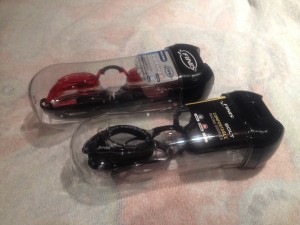
The Finis Lightning
The lightning is a very adjustable minimalist racing goggle. The lenses come in your choice of red, blue or aqua. Each set of goggles comes with 4 nosepieces to get a good fit.
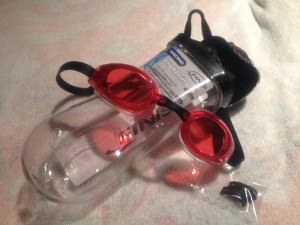
The Lightning also has a quick adjustment strap which makes getting the band to the right level of fit pretty easy.
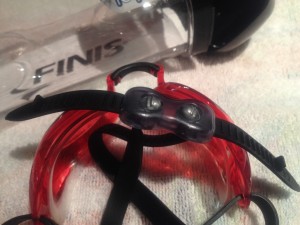
I really enjoyed swimming with the Lightning. The minimalist eyecup really fits my face well. I found the optical quality of these goggles to be superior to many I’ve tried with very little distortion. I expect this is because the eye cup is so small that you rarely look through anything but the main lens part of the cup.
The Finis Bolt
The Bolt is a larger eyecup racing goggle. Labeled as a comfortable racing goggle it has a little more padding than the Lightning and with the larger eye cup may give wearers a little less eye strain than a smaller more minimalist goggle. The Bolt also comes with 4 interchangeable nose bridges and a fully adjustable strap to get a good fit.
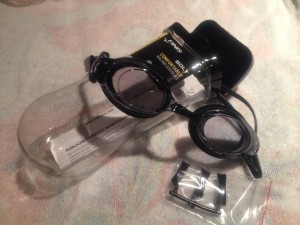
For me, the Bolt required a bit of fussing to get a good facial fit. Unlike the Lightning that formed a great fit to my face, the Bolt needed some nose bridge and strap adjusting to get a watertight seal. Once it was there though, it was solid and comfortable.
General Comments
Both of these are good goggles. They are both very adjustable and have good optics. Both have UV and anti-fog coatings. With respect to anti-fog coatings, I must have very moist eyes or sweat through my eyes a lot because I find that unless I use an anti-fog product on my goggles, after 10-15 minutes of effort, they all fog. Both of these goggles lasted about 30 minutes before starting to fog, which may speak to having a really superior anti-fog coating and just my body’s ability to overcome them 🙂
If you’re in the market for goggles, definitely check these out. Like so many things, this is especially true with goggles: one size does not fit all. Make sure to get a goggle that suits your face shape and you’ll be setup for many hundreds of hours of leak free swimming.
Posted on Aug 26, 2012 under Raves |
In my blog overview of music while you train devices, I mentioned the Cardo BK-1 Duo as an on-bike bluetooth enabled wireless device for getting music from an iphone (or other bluetooth enabled music player) to your ears in a way that doesn’t interfere with ambient traffic noise, etc. I wrote that I really like the BK-1 for this and that the bluetooth reception is amazing, with no drop-outs and great signal strength. But the BK-1 is so much more.
The BK-1 is a bluetooth enabled full-on, voice activated transceiver. It gives you bike to bike easy to use and quality communications for up to 3 riders at a range of about 500m.
The BK-1 Duo comes in nice hard-shell protective box, seen here beside my RudyProject helmet for sizing. This helmet will soon be BK-1’d.
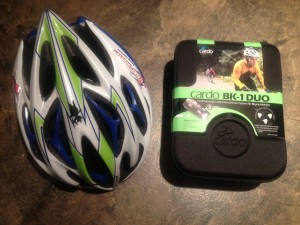
Unpacking the box, everything you need to install the setup is included, right down to alcohol swabs to clean the velcro mount points on your helmet.
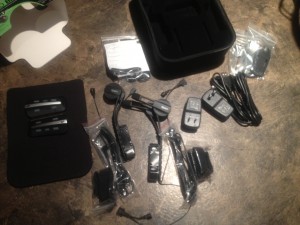
The Duo even comes with 2 chargers so that you can charge both radios at the same time, in different locations. I was at first surprised they didn’t just provide a dual charger, but the 2 chargers later made more sense.
Installation is pretty quick and easy, but does require a little trial and error to get the mounts in the right place for the earphones to comfortably cover your ears.
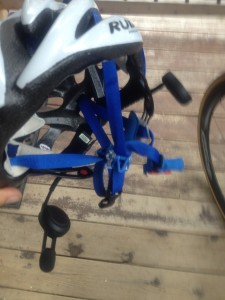
As I said in my music survey, the BK-1 is great for on-bike tunes, the battery lasts over 6 hrs from experience in my longest training/test ride. What’s really surprising is the transmission sound quality from the little boom microphone.
I had assumed that wind noise would be a terrible issue with the BK-1, either when using it as a cell phone headset or when used for bike-to-bike communications. Not so! Cardo has done a great job of isolating (and perhaps electrically filtering?) wind noise. It’s barely perceptible to the listener when you’re in motion, sure there’s ambient noise that gets picked up, but you have to expect that. Still the transmission quality of the BK-1 and the isolation of your voice from background noise is pretty amazing. The voice activation feature is solid, without word clipping or transmission delays (very much unlike the old VOX systems of the past where your 1st and last words of any sentence would never reach the listener).
Range-wise I found the advertised range of 500m to be pretty accurate, depending on terrain. On a flat, straight, open road, the useable range was closer to 600m, but this dropped off in hills or forest to closer to 300-400m, still very acceptable in my opinion. In really dense forest, on single-track trails with lots of hills and corners, the BK-1 started to have some troubles and the range dropped pretty low (we didn’t measure but it was pretty much the case of “I need to be able to see you”).
The BK-1 is a 1st gen product, but they have built software upgrade-ability into the devices so as they work on upgrades you’re not stuck with an end-of-life product, which is very nice.
One thing that occurred to me, late in the season, was that the BK-1 could also be a great coaching tool: coach with 1 unit, athlete with the other on the bike. The coach could drive a car and be providing feedback to the rider in a way that doesn’t require them both to stop and have a conversation. This could be extremely useful when trying to adjust form or provide technique coaching “on the fly”.
All in, I really like the Bk-1. While I normally train solo, it’s an amazing on-bike music and bluetooth headset device and when I have the opportunity to go for a social ride, it’s super-nice to have easy bike to bike communications. By far, the BK-1 is the leader in this space today with a solid product launch and a long history of radio communications, I expect great things for the BK-1’s future.
Posted on Aug 22, 2012 under Raves |
I had the fortune of having a set of RecoveryPump legs to aide in my post Ironman recovery.
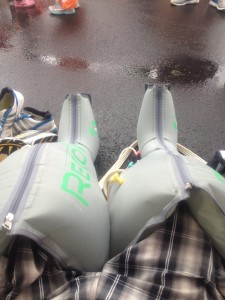
For those of you who haven’t seen or heard of the RecoveryPump system, it’s a set of 2 leg-sleeves each with 4 air compartments and a timed compressor pump. The pump compresses air at 80psi sequentially into the air compartments starting at your feet and moving up your legs, holds for a few seconds and releases. The idea is that the squeezing pushes the metabolic waste up out of your legs and then with the release fresh blood is allowed back into your legs thus speeding and enhancing recovery. This is along the same idea as compression socks/tights, but with significantly more force. Also the forces applied are sequenced and controlled (rather than just constant with compression wear) and so further aide the flushing of waste.
Shortly after I finished my Ironman race in Mont Tremblant, I headed back to my hotel, did my normal post exercise stretch routine and then put the legs on for about 2 hours while laying in bed. The compressions release cycle is very soothing and relaxing and while I didn’t sleep with them on, I probably could have. 🙂 After 2 hrs, I took off the leggings and my legs (which didn’t really feel terrible after the race) felt pretty good. Tight and fatigued but certainly far from crippled.
In the morning when I woke, I lay in bed dozing and surfing the net and put the legs back on for another 1.5 hrs. When I got up, my legs felt “almost normal”. Stairs weren’t a problem, walking wasn’t a problem. Sure, I wasn’t about to go out dancing, but my legs have definitely felt worse after just a long training ride then they did post Ironman and RecoveryPump treatments!
Walking around in the Ironman/Mont Tremblant resort village on Monday I saw many people who looked like their legs had been run over by trucks. They were walking with a great deal of pain and stiffness. I almost felt guilty that my legs felt so good.
Almost. 🙂
So BIG THUMBS UP for RecoveryPump! Definitely need to get me a set of these and build them into my training/recovery program. If they can do this for me post Iron-distance race, the differences in day-to-day training will also be awesome!
Posted on Aug 14, 2012 under Raves |
This isn’t really triathlon related, but I just got my BigSkinny wallet and I just have to tell you about it. I first saw the bigskinny wallet on the CoolTools Blog. It looked pretty cool and inexpensive so I ordered one. I have to say, I’m SO happy with it.
If you’re like me, your wallet has a mix of cash, 5-8 credit cards, a few ID cards (driver’s license, etc.), some affiliate cards (Starbucks, etc.), some membership cards, etc. etc. etc. My old leather wallet, when loaded, was so big that I really couldn’t comfortably put it in my jeans or shorts pocket (I’ve long since stopped sitting on my wallet and now put it in my front pockets rather than rear, but still “too big” is “too big”). My BigSkinny wallet, fully loaded with everything from my old wallet is… get this… the bigskinny wallet, full, is thinner than my old leather wallet _EMPTY_!.
This pic is from BigSkinny’s website, but it’s so true:

Pretty happy with it. Check them out!
Posted on Aug 06, 2012 under Raves |
As part of my survey of music while you train devices I bought a set of Jaybird Freedom bluetooth headphones.
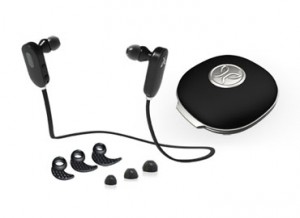
The Jaybirds come with a variety of different in-ear cushions, ear locks and over ear hoops to get the best fit for the wearer. They are a full bluetooth transceiver with a microphone for placing bluetooth calls as well as quality stereo sound for music, podcasts, etc.
In my testing I found the bluetooth reception to be very good, with very few drop-outs regardless of where my iphone was located. Jaybird suggests a specific body location, but I had no problems with my phone in my left hip pocket, or in a hip bag or fanny-type pack. I’ve also been really impressed with the 6+ hours of battery life that the Jaybirds have: one of my biggest complaints with wireless music is the almost constant need to recharge. Not so with the jaybirds. I really enjoy the sound quality that the Jaybirds provide and regularly use them in my walking-commute to and from work.
Unfortunately, when I’m running, I find the cushioned in-ear style ear-bud provide a noisy interface between my body and ear… i.e. I hear every jostling of my head, every foot-fall (no matter how soft), and while the general muting of the ambient environment would normally allow for lower volume levels, the increased, lets call it “exertion noise”, counteracts that.
I really want to love the Jaybird Freedom headphones and as a generic stereo headphone I do; however, for me, for running, I have a really hard time with the exertion noise and really have to be in a tolerant headspace to get past it. On the bike, I wouldn’t use them because of the in-ear muting nature of the foam inserts. In the gym, or on the stationary, they’d be a definite win.
Posted on Jul 22, 2012 under Raves |
StayFill Review – Slowtwitch.com.
I’ve been wondering for years why this didn’t exist… happy to see that it finally does! Now… to me me some!
Posted on Jul 13, 2012 under Raves |
I’ve recently been working with 2 very different paddles from Finis: the PT Paddle (the paddle you’ll love to hate) and the Agility Paddles. These paddles work very different skills in the water and are both extremely efficient.
The PT Paddle

PT stands for Perfect Technique. These paddles effectively remove any advantage your hands may have in your catch or stroke, but keep your hand in a natural swimming position (unlike fist drills). By removing the ability to use your hand in your stroke, you’re forced to enlist your forearm and body position more effectively to move yourself forward. I’ll tell you, from several hours of personal experience, that these paddles do exactly that.
When you first put on the PT paddles and start swimming, you feel like you’re flopping around in the lane (definitely move down a lane (or two) when you start using these, unless you already have great form). Your arms feel like they’re paddling around through the air and your tempo is definitely impacted. A good time to start with these is when the pool is slammed with people who are slower than your normal pace – it’s a handicap that will improve your form. 🙂 After a few lengths you’ll have started enlisting better form. As you go, you’ll actually start to approach (or perhaps surpass) your normal pace. Don’t stop at this point though: you’re (re)training your body and establishing new form – if you stop too soon, you’ll lose your gains.
After you’ve put in a bunch of time with the paddles, take them off and go back to a catch where you can use your hand, but try to not revert to hand-dependency. You’ll immediately feel the difference in your swim and how much harder you have to work with your hand at the end of your arm. Because you’re building new form, I suggest not doing too much of a swim after using the paddles, rather, get out of the water and let the new form “sink in”.
Because you’re pulling less water with each stroke, the PT paddles also make for a good time in working to increase your stroke cadence and get those neural pathways set as well.
The Agility Paddle
Finis released the agility paddle earlier this year, they’re very popular and can be a little hard to find, and with good reason.

Unlike many (all?) other paddles on the market, the agility paddle is held on your hand by placing your thumb through the hole in the paddle. That small pinch, combined with the force of the water against the paddle is all that keeps the paddle in place. Similarly, if your hand position is bad in your catch or just before your recovery starts, the water will happily pull the paddle out of position alerting you to your problem(s). Similarly, if your catch enters the water without a good forward stretch or if you’re stalling in your stroke, the paddles will react to the water flow and push out of place or fall off completely.
I had been using the little sculling paddles with all but the middle-finger strap removed and achieving some similar results; however, the sculling paddles are a bit small and force an unnatural hand position. The agility paddles keep your hand in an excellent swimming position, and due to their size also give you a good pull work-out, while all the time, helping to improve your stroke and hand position.
Two great products from Finis to help you improve your swim! Train hard! 🙂
Posted on Jul 11, 2012 under Raves |
ROAD magazine reviewed the new EFS Kona-Mocha liquid shot in the July 2012 issue and had this to say:
http://www.firstendurance.com/2012/06/efs-kona-mocha-liquid-shot-awarded-highest-marks/
This doesn’t surprise me at all! EFS Liquid Shot has been my go-to for years and the new Kona-Mocha flavour is absolutely the best!



















